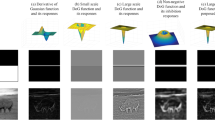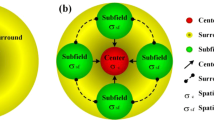Abstract
In this paper we present an artificial cortical network, inspired by the Human Visual System (HVS), which extracts the salient contours in color images. Similarly to the primary visual cortex, the network consists of orientation hypercolumns. Lateral connections between the hypercolumns are modeled by a new connection pattern based on co-exponentiality. The initial color edges of the image are extracted in a way inspired by the double-opponent cells of the HVS. These edges are inputs to the network, which outputs the salient contours based on the local interactions between the hypercolumns. The proposed network was tested on real color images and displayed promising performance, with execution times small enough even for a conventional personal computer.
This research was funded by the project PENED 2003 – KE 1354.
Preview
Unable to display preview. Download preview PDF.
Similar content being viewed by others
References
Alter, D., Basri, R.: Extracting Salient Curves from Images: An Analysis of the Salience Network. International Journal of Computer Vision 27, 51–69 (1998)
Mahamud, S., Williamns, R., Thornber, K., Xu, K.: Segmentation of Multiple Salient Closed Contours from Real Images. IEEE Transactions on Pattern Analysis and Machine Intelligence 25, 433–444 (2003)
Wang, S., Kubota, T., Siskind, M., Wang, J.: Salient Closed Boundary Extraction with Ratio Contour. IEEE Transactions on Pattern Analysis and Machine Intelligence 27, 546–560 (2005)
Lance, W., Karvel, T.: A Comparison of Measures for Detecting Natural Shapes in Cluttered Backgrounds. International Journal of Computer Vision 34, 81–96 (2000)
Field, J., Hayes, A.: Contour Integration and the Lateral Connections of V1 Neurons. The Visual Neurosciences. MIT Press, Cambridge (2004)
Kapadia, K., Westheimer, G., Gilbert, D.: Spatial Distribution of Contextual Interactions in Primary Visual Cortex and in Visual Perception. F. Neurophysiology 84, 2048–2062 (2000)
Yen, C., Finkel, L.: Extraction of Perceptually Salient Contours by Striate Cortical Networks. Vision Research 38, 719–741 (1998)
Li, Z.: A Neural Model of Contour Integration in the Primary Visual Cortex. Neural Computation 10, 903–940 (1998)
Choe, Y., Miikkulainen, R.: Contour Integration and Segmentation with Self-Organized Lateral Connections. Biological Cybernetics 90, 75–88 (2004)
Mundhenk, N., Itti, L.: Computational Modeling and Exploration of Contour Integration for Visual Saliency. Biological Cybernetics 93, 188–212 (2005)
Grossberg, S.: Visual Boundaries and Surfaces. The Visual Neurosciences. MIT Press, Cambridge (2004)
Parent, P., Zucker, W.: Trace Inference, Curvature Consistency, and Curve Detection. IEEE Transactions on Pattern Analysis and Machine Intelligence 11, 823–839 (1989)
Vonikakis, V., Andreadis, I., Gasteratos, A.: Simple-Shape Classification Based on the Human Visual System. In: IASTED Int. Conf. on Visualization, Imaging and Image Processing, pp. 162–167 (2005)
Vonikakis, V., Gasteratos, A., Andreadis, I.: Enhancement of Perceptually Salient Contours using a Parallel Artificial Cortical Network. Biological Cybernetics (accepted for publication)
Hubel, D., Wiesel, T.: Receptive Fields and Functional Architecture in Nonstriate Areas (188 and 19) of the Cat. Journal of Neurophysiology 28, 229–289 (1965)
Plataniotis, K., Venetsanopoulos, A.: Color Image Processing and Applications. Springer, Heidelberg (2000)
Lennie, P.: Color coding in the cortex. Color Vision – From Genes to Perception. Cambridge University Press, Cambridge (1999)
Author information
Authors and Affiliations
Editor information
Editors and Affiliations
Rights and permissions
Copyright information
© 2006 Springer-Verlag Berlin Heidelberg
About this paper
Cite this paper
Vonikakis, V., Andreadis, I., Gasteratos, A. (2006). Extraction of Salient Contours in Color Images. In: Antoniou, G., Potamias, G., Spyropoulos, C., Plexousakis, D. (eds) Advances in Artificial Intelligence. SETN 2006. Lecture Notes in Computer Science(), vol 3955. Springer, Berlin, Heidelberg. https://doi.org/10.1007/11752912_40
Download citation
DOI: https://doi.org/10.1007/11752912_40
Publisher Name: Springer, Berlin, Heidelberg
Print ISBN: 978-3-540-34117-8
Online ISBN: 978-3-540-34118-5
eBook Packages: Computer ScienceComputer Science (R0)




